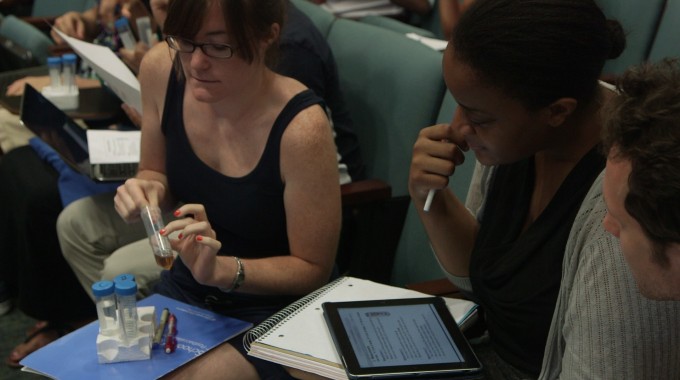If you know of a Columbia College student, faculty member, alumnus/alumna or program we should spotlight, or if you would like to submit a story, please contact:
Columbia College
Office of Communications
cc-comms@columbia.edu

“I’m happy with this new approach. I couldn’t imagine going back to the old style.” — Brent Stockwell, professor of Biological Sciences and Chemistry
Professor of Biological Sciences and Chemistry Brent Stockwell not only encourages his students to use smartphones and tablets in class – he requires it.
Determined to make class time more valuable, during summer 2013, Stockwell enlisted the services of the Columbia Center for New Media Teaching and Learning (CCNMTL) to redesign his “Biochemistry: Structure and Metabolism” course using digital tools.
Stockwell wanted his students to be better prepared for class and to have incentives to attend even though lecture slides are available on Courseworks. He also sought to make the material more accessible for students who struggle to grasp scientific concepts in the traditional format. “If it’s just a passive lecture, and you can deliver that to people around the world, then what is the value added for students to be at Columbia?” says Stockwell. “There should be some advantage to being physically present.”
With those goals in mind, Stockwell worked with Michael Cennamo, a senior educational technologist at CCNMTL, to develop a “blended learning” model that requires students to watch prerecorded lectures and complete corresponding quizzes for homework. Class time is devoted to discussions, during which students use smartphones or tablets – for the students in the class who do not have their own, iPads are supplied by Columbia College Information Technology – to answer questions anonymously via a web-based audience response system. The questions, which are graded, provide Stockwell with instant feedback. “He is a more agile teacher because he’s seeing, in real time, if his students are getting the concepts, and must then make the decision to back up or go forward,” says Cennamo.
Leila Musavi CC’15, a pre-med student, found the in-class polling useful when studying for exams. “You could tell what the really important information was by the types of questions he asked in class,” says Musavi, who is returning to the class as one of Stockwell’s teaching assistants in fall 2014.
During class, Stockwell’s students also tackle biochemistry problems in small groups formed at the beginning of the semester. The scenarios are generally too challenging for any one student and therefore require collaboration. “I wanted to bring that aspect of actual research into the classroom and have students feel they are working together to conquer the material,” says Stockwell.
Problem-solving with his peers was a highlight of the course for Aaron Shea CC’09, a post baccalaureate pre-med student who is also returning as a teaching assistant in fall 2014. “Being able to talk over [the problems] and see faults in your logic and other people’s logic is really good,” he says.
According to Cennamo, Stockwell’s course both builds upon and goes beyond an established teaching model known as a “flipped classroom” in which lectures and discussion time are reversed. “It’s more than flip,” says Cennamo. “In my opinion, the ‘flipped classroom,’ can be seen as a bit binary, whereas this has more pieces to it that complement each other.”
Stockwell, who further explored pedagogical strategies at the National Academies Summer Institute on Undergraduate Education in Science in summer 2014, finds that attendance improves under the “blended learning” model and that it allows him to better pinpoint students’ misconceptions. “I’m happy with this new approach,” he says. “I couldn’t imagine going back to the old style.”
Nathalie Alonso CC ’08, from Queens, is a freelance journalist and an editorial producer for LasMayores.com, Major League Baseball’s official Spanish language website. She writes “Student Spotlight” for Columbia College Today. This story appeared in the 2013–2014 Columbia College Annual Report.